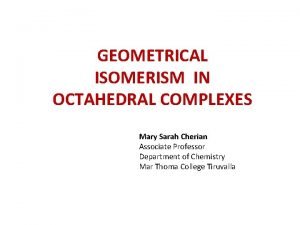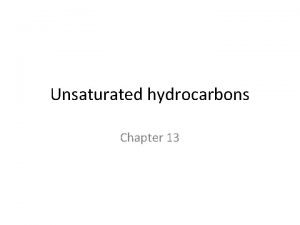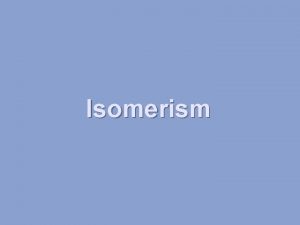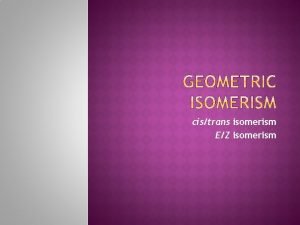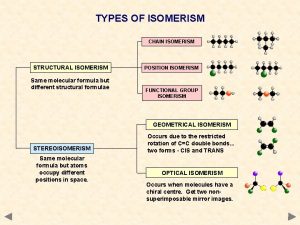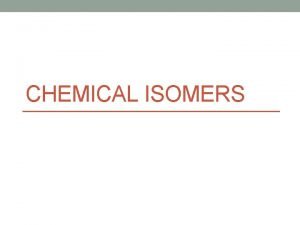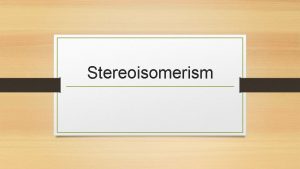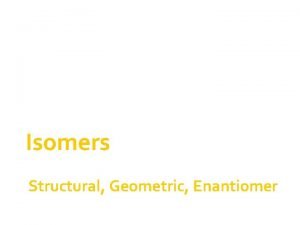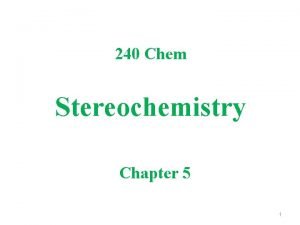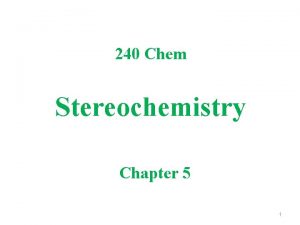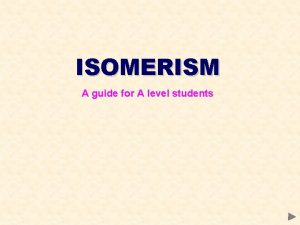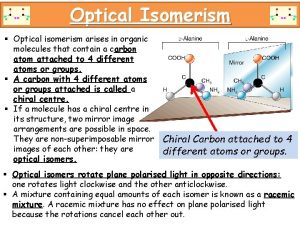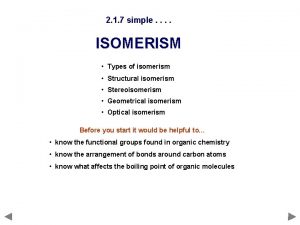Chapter 2 Isomerism Isomerism Isomers are compounds that















- Slides: 15

Chapter 2 Isomerism

Isomerism Isomers are compounds that have the same formula but different structures Structural Isomerism 1 - Skeletal Isomerism 2 - Positional Isomerism 3 - Functional Isomerism 4 - Tutomeric Isomerism Stereo Isomerism 1 - Geometric Isomerism

Structural or Constitutional Isomerism Are isomers whose atoms have a different connectivity 1 - Skeletal Isomerism The structure is different but the formula is constant for all. Example: Skeletal Isomerism of C 6 H 14

Structural Isomerism 2 - Positional Isomerism Only the position of the functional group is different. Example: Positional Isomerism of C 6 H 14 O

Structural Isomerism 3 - Functional Isomerism The type of the functional group is different. Example 1: Functional Isomerism of C 3 H 6 O Ketone Aldehyde Example 2: Functional Isomerism of C 2 H 6 O Alcohol Ether

Structural Isomerism 4 - Tutomeric Isomerism Example: Tutomeric Isomerism of C 5 H 8 O 2

Stereo isomerism Isomers that have the same connectivity but that differ in the arrangement of their atoms in space 1 - Geometric Isomerism q This type of isomer occurs when no free rotation is available in Alkenes and Cycloalkanes. q If two hydrogens occur on the same side of the double bond the compound is cis- (Latin word means on the same side) q If they are on opposite sides the compound is trans- (Latine word means on the opposite side) no free rotation around the double bond

Example 1: Geometric Isomerism of Cl. CH=CHCl trans- cis- Example 2: Geometric Isomerism of (CH 3)CH=CH(CH 3) cis-2 -butene trans-2 -butene 8

Example 3: Geometric Isomerism of 1, 3 -dimethylcyclobutane cis-1, 3 -dimethylcyclobutane trans-1, 3 -dimethylcyclobutane

v The (E)-(Z) System for Designating Alkene Diastereomers § Cis- and trans- terms was used to designate the stereochemistry of disubtituted alkene. § If the alkene is trisubstituted or tetrasubstituted, the terms Cis- or Trans- are either ambiguous or not applied at all. § Consider the following alkene as an example: § Its impossible to decide whether of the following compounds cis- or transsince no two identical groups available.

§ A system that used in all cases is based on the priorities of substituted groups called the (E)-(Z) System. H If the group of highest priority on one carbon is on the same side as the group of highest priority on the other carbon the double bond is Z (Zusammen) H If the highest priority groups are on opposite sides the alkene is (Entgegen) E

Using the (E)-(Z) System, give the IUPAC names for each of the following compounds:

Think about this case: No cis- or trans- isomers No (E )or (Z ) system (E )system (Z )system trans- isomers (E ) system cis- isomers (Z ) system trans- isomers (E )system cis- isomers (Z )system

Using the (E)-(Z) System, give the IUPAC names for each of the following compounds: (E ) 1 -bromo 1 -chloro-1 -pentene (E ) 2 -bromo 1 -chloro-1 -iodo-1 -butene (Z ) 3, 4 -dimethyl-2 -hexene

t Relative Stabilities of Alkenes è Generally cis- alkenes are less stable than trans- alkenes because of steric hinderance (crowding by the adjacent alkyl groups). cis- trans- This effect can be measured quantitatively by comparing thermodynamic data from experiments involving the alkenes with related structures, as we shall see below: 15
 Insidan region jh
Insidan region jh Diastereomers vs enantiomers
Diastereomers vs enantiomers![Complexes of the type [m(aa)3]±n show Complexes of the type [m(aa)3]±n show](data:image/svg+xml,%3Csvg%20xmlns=%22http://www.w3.org/2000/svg%22%20viewBox=%220%200%20200%20200%22%3E%3C/svg%3E) Complexes of the type [m(aa)3]±n show
Complexes of the type [m(aa)3]±n show Define geometrical isomerism
Define geometrical isomerism Ngoại tâm thu thất chùm đôi
Ngoại tâm thu thất chùm đôi Block xoang nhĩ độ 2 type 1
Block xoang nhĩ độ 2 type 1 Thơ thất ngôn tứ tuyệt đường luật
Thơ thất ngôn tứ tuyệt đường luật Thơ thất ngôn tứ tuyệt đường luật
Thơ thất ngôn tứ tuyệt đường luật Walmart thất bại ở nhật
Walmart thất bại ở nhật Tìm vết của đường thẳng
Tìm vết của đường thẳng Con hãy đưa tay khi thấy người vấp ngã
Con hãy đưa tay khi thấy người vấp ngã Tôn thất thuyết là ai
Tôn thất thuyết là ai Gây tê cơ vuông thắt lưng
Gây tê cơ vuông thắt lưng Sau thất bại ở hồ điển triệt
Sau thất bại ở hồ điển triệt Ionic covalent and metallic bonds
Ionic covalent and metallic bonds Types of unsaturated hydrocarbons
Types of unsaturated hydrocarbons

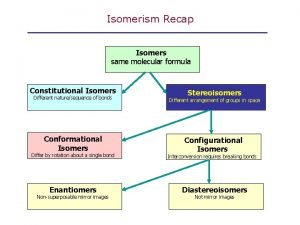
![Complexes of the type [m(aa)3]±n show Complexes of the type [m(aa)3]±n show](https://slidetodoc.com/wp-content/uploads/2020/12/3015715_d8412bc28f0c7b6a8c2ea3744ce60d97-300x225.jpg)
